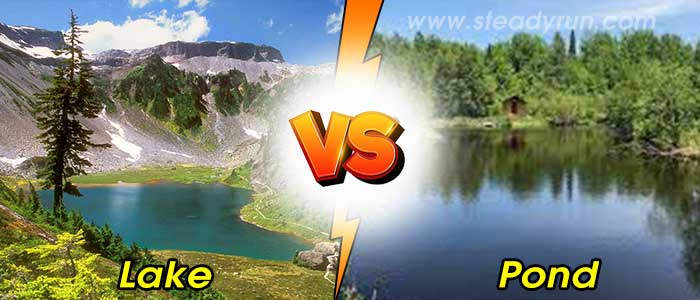How to Use Design Principles to Boost Your YouTube Channel's Appeal

The age-old question: What really makes a lake different from a pond? While many people use these terms interchangeably, there are fascinating scientific and ecological distinctions between these freshwater bodies that set them apart in surprising ways.
Defining the Basics: Size, Depth, and Science
What Makes a Lake a Lake?
Lakes are typically characterized by their substantial size and depth. These large water bodies usually span several acres and have sufficient depth to support distinct thermal layers. The key differentiator is that lakes are deep enough to develop stratification - where different water layers have varying temperatures and oxygen levels.
What Qualifies as a Pond?
Ponds, in contrast, are generally smaller and shallower. Most ponds are less than 6-20 feet deep and receive sunlight throughout their entire water column. This means the bottom areas receive enough light for plants to grow, creating a fundamentally different ecosystem than lakes.
The Technical Distinctions
Depth and Light Penetration
The most crucial difference lies in light penetration and depth relationship:
- Lakes: Deep enough that sunlight cannot reach the bottom, creating distinct zones
- Ponds: Shallow enough for sunlight to penetrate to the bottom, supporting plant growth throughout
Thermal Stratification
Lakes undergo thermal stratification during warmer months, developing three distinct layers:
- Epilimnion: Warm surface layer
- Metalimnion: Middle transition layer
- Hypolimnion: Cold deep layer
Ponds typically don't develop these layers due to their shallow depth, maintaining more uniform temperature throughout.
Size Matters: The Great Debate
Surface Area Differences
While definitions vary globally:
- Ponds: Usually less than 5 acres
- Lakes: Typically over 20 acres, with some definitions requiring 100+ acres
Volume and Retention Time
Lakes hold significantly more water and have longer water retention times. Some lake water can take years to completely cycle through, while pond water often replaces itself seasonally.
Ecological Differences
Biodiversity Variations
Lakes support complex food webs with:
- Distinct habitat zones
- Specialized deep-water species
- Complex predator-prey relationships
- Greater species diversity overall
Ponds create simpler ecosystems:
- Uniform habitat conditions
- Shallow-water adapted species
- Clear visibility for predators
- Seasonal population fluctuations
Water Quality Characteristics
Lakes often have:
- Higher nutrient concentration in deep layers
- Potential for oxygen depletion in bottom waters
- Complex chemical stratification
Ponds typically feature:
- More uniform oxygen distribution
- Faster nutrient cycling
- Greater temperature fluctuations
Geographic and Formation Facts
Natural vs. Artificial Origins
Both lakes and ponds can be natural or human-made:
- Natural lakes: Often glacial, tectonic, or volcanic in origin
- Artificial lakes: Created by damming rivers
- Natural ponds: May form in depressions, beaver activity, or seasonal flooding
- Artificial ponds: Constructed for farming, aesthetics, or wildlife management
Global Distribution
Fascinating Global Statistics:
- Canada alone has over 3 million lakes
- The Great Lakes contain 21% of the world's surface freshwater
- Most ponds are smaller than a football field
- Finland has more saunas than lakes (though both are abundant!)
Human Impact and Usage
Economic Importance
Lakes provide:
- Commercial fishing opportunities
- Transportation routes
- Hydroelectric power generation
- Tourism and recreational activities
- Water supply for communities
Ponds serve:
- Agricultural irrigation
- Ornamental purposes
- Wildlife habitat creation
- Educational research
- Small-scale fishing
Environmental Indicators
Both water bodies serve as environmental health indicators, but ponds often show changes more rapidly due to their smaller volume and faster water exchange rates.
Special Cases and Exceptions
The Great Lakes Example
The five Great Lakes (Superior, Michigan, Huron, Erie, and Ontario) are technically massive inland seas, yet we call them lakes. This demonstrates that naming often depends on cultural and historical factors, not just scientific definitions.
Seasonal Variations
Some water bodies change classification seasonally:
- Vernal pools: Temporary ponds that dry up seasonally
- Wetlands: May be classified as shallow ponds during wet seasons
- Reservoirs: Artificial lakes with varying depths
Practical Identification Tips
Quick Ways to Differentiate
- Depth Test: Can you see the bottom? If yes, likely a pond
- Size Assessment: Can you see the opposite shore? Small ponds are typically visible shore-to-shore
- Temperature Variation: Does the water temperature change significantly with depth? This indicates a lake
- Ecological Observation: Complex versus simple food webs often indicate lakes versus ponds
Why This Knowledge Matters
Understanding the difference between lakes and ponds isn't just academic—it has real-world implications for:
- Environmental protection strategies
- Recreational planning and safety
- Aquatic ecosystem management
- Property development considerations
- Climate change impact assessments
Fun Facts to Remember
- Deepest lake: Lake Baikal in Russia holds 20% of the world's unfrozen fresh water
- Highest lake: Lake Titicaca sits at 12,500 feet above sea level
- Oldest pond: Some natural ponds have existed for thousands of years
- Smallest lake: Technically, many states consider any named body of water with specific recreational use as a "lake"
Conclusion: It's All About Context
The difference between a lake and pond ultimately depends on depth, size, thermal characteristics, and ecological complexity. While scientists can measure and classify these water bodies objectively, local naming conventions often reflect cultural and historical contexts rather than strict scientific definitions.
Whether you're calling it a lake or pond, these freshwater ecosystems are vital to our planet's biodiversity and human civilization. The next time you visit a local water body, you'll now have the knowledge to appreciate not just its beauty, but its unique ecological significance.
Remember: Size isn't everything—depth, ecosystem complexity, and thermal characteristics are equally important in distinguishing lakes from ponds. Both play crucial roles in our environment, supporting diverse life forms and providing essential resources for human communities worldwide.
Understanding the difference between lakes and ponds helps us better appreciate these vital freshwater ecosystems and supports more effective conservation efforts for both.
Tags:
Difference between Pond vs Lake
Lake vs Pond
Differences between Pond vs Lake
Image Credits: Freepik








